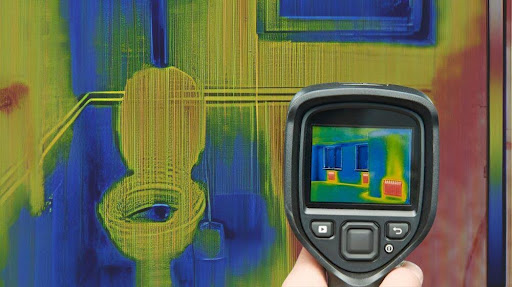Infrared imaging, or thermography, can photograph objects you can’t see. Although it sounds difficult, infrared imaging is a straightforward and inexpensive approach to identifying hidden water damage or wood rot in your home. Restoration professionals and workers use this effective instrument to find better ways to fix water and moisture leaks. Here in this blog, you will get more information on how infrared cameras find hidden water damage.
Understanding Infrared Imaging
IR cameras detect heat waves, not water. Everything generates infrared energy, which increases with temperature. Infrared cameras capture this heat and display it as thermal images. Warmer surfaces are red or orange, whereas cooler ones are blue, green, or purple.
Wet construction materials stay cooler because water evaporates.
Temperature differences between dry and damp areas typically create thermal patterns on surfaces scanned by thermal cameras. This discrepancy can indicate where water pooled after a leak, flood, or HVAC failure.
How Water Affects Temperature Readings
Water affects heat and cold. In general, moist materials hold heat differently. Drywall may quickly heat or cool. The wet area close to it may react more slowly. So, infrared cameras find hidden water damage.
After a flood catastrophe, restoration experts employ HVAC systems or fans to make the room more pleasant before scanning. The dry-wet temperature differential increases with temperature. This difference is usually easier to perceive when surfaces are cooler, such as when the air conditioner is on or after dark.
Practical Restoration Use
Thermal imaging accelerates moisture mapping. Large walls, ceilings, and floors in complex buildings can be scanned fast by IR cameras. If a pipe leak is buried by tile or water in wall cavities, the camera may detect a chilly patch or uneven heat signature.
After using infrared to discover a potential problem, specialists employ moisture meters to confirm and measure the moisture. Thermal photography followed by meter testing prevents unnecessary damage to neighboring items. It also provides concentrated drying and minimizes mitigation delays.
Detecting Moisture in Different Building Materials
Thermal images look varied because different materials respond to water in different ways. For example:
Drywall
When wet, it reveals distinct cold patches, particularly if the moisture is confined beneath the paper’s surface.
Concrete
Large wet zones can still be seen, but it takes longer to cool and doesn’t always produce significant thermal contrast.
Wood framing
It can hide minor leaks if it’s well-insulated or in an area without moisture.
Insulation
When insulation is soaked with water, it can form soft, chilly patches that are easily visible on infrared scans.
Seattle water damage restoration experts adjust camera settings and scanning angles based on the material. Not every warm area is dry, and not every cool area is wet. An experienced operator can interpret infrared cameras to find hidden water damage.
Environmental Conditions Also Matter
The accurate operation of thermal cameras is conditional on certain factors. Solar radiation, airflow, surface exposure, and inside temperature all have an impact on thermal measurements.
A sun-heated wall that absorbs heat unevenly can give inaccurate results when scanned. Also, if you run your air conditioner or heat pump too close to the scan period, you can get false cold streaks. To prepare for scanning, restoration crews may alter airflow, close windows, or wait for surfaces to stabilize. This makes the reading more accurate and makes the heat profile more visible.
Another factor is humidity. Condensation, which can occur on surfaces due to high humidity, sometimes gives the impression of water damage, but it isn’t actually that deep. For moisture confirmation, technicians must use infrared inspection, hygrometers, and pin-type or pinless moisture meters.
Benefits of Using Infrared Cameras
When water damage restoration experts use infrared imaging, it improves the speed and accuracy of inspections in multiple ways:
- No need to open up walls or ceilings without cause.
- Quickly surveys large areas to focus drying efforts.
- Find water before it leads to structural damage or mold.
- Thermal images help support insurance claims and restoration reports.
- Identifies hidden risks like wet electrical areas or sagging drywall.
Because the camera doesn’t physically interact with surfaces, it also allows inspection in fragile or contaminated areas. In homes affected by sewage backflow or mold infestations, limiting contact helps reduce cross-contamination and health risks.
Conclusion
Infrared cameras find hidden water damage and have become an important gadget in water damage restoration. When used properly, IR imaging helps professionals act faster, dry better, and prevent long-term harm from hidden water.
If you need instant water damage restoration, contact Seattle water damage restoration experts now. We use infrared technology to provide you with complete water damage restoration services while reducing your stress and saving time and money.



